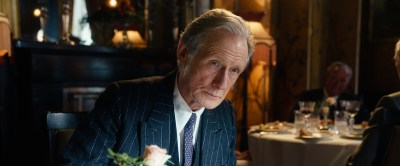
A few remaining travel tips and sightings from our recent trip to South Georgia and Alabama. We stayed in wonderful hotels. I mentioned already the Plains (Georgia) Historic Inn. In Montgomery, our hotel was the Renaissance Montgomery Hotel, a lovely modern property with a super-convenient location. Check out the photomural behind the bed! Interesting contemporary art throughout. A conference of veterinarians who’d graduated from Tuskegee University was under way when we were there. I’d overhear them discussing their “patients,” and suddenly realize said patient was a farm animal probably weighing 1500-2000 pounds!
In Atlanta we stayed at the historic Candler Hotel on Peachtree Street, an art deco gem (lobby pictured below) now part of the Curio Collection by Hilton, that has an excellent restaurant. The only drawback is that it is little awkward to get to, because the entrance is on a short one-way street. Required circling.

We were in Alabama when those awful storms went through the area, causing multiple deaths. We weren’t caught up in that, but when we toured Selma, we saw where a recent tornado there had done massive damage. It was several weeks before our visit, but roof repairs were still under way, trees toppled, and much structural damage to homes.
One Montgomery site that didn’t fit in to the literary, presidents, or civil rights themes of last week’s posts was Old Alabama Town, a square block-plus near downtown (as everything is) where a collection of 1800s buildings has been relocated. Visitors can go inside most of them, including the general store, the “First Presbyterian Colored Church,” a schoolroom, a cotton gin, a shotgun house, and a dogtrot house. The reception building for the attraction is, not surprisingly, a historic tavern. Although the buildings are mostly empty, a fully restored house is also part of Old Alabama Town. The Ordeman-Shaw Townhouse and associated dwelling for the family’s enslaved people are furnished and the subject of a lively tour.

In Gadsden, Alabama, we visited a state park with a notable waterfall (rainbow slightly visible in front of and below it): the Noccalula Falls Park, which has a variety of features, including a miniature train whose short ride provides an overview of the layout.
At the park, I snapped this picture of a hawk and black squirrel. The squirrel must have been climbing the tree when the hawk appeared, from which moment, it had the squirrel’s undivided attention. The hawk would fly from a branch on one side of the tree to the other, and the squirrel quietly circled the tree trunk, taking pains to keep the trunk between the two of them. We left before the final scene of this drama. Some things I’d just rather not know!

The rest of the series:
Brushes with Literary Fame (Lee, Capote, O’Connor, and more)
“Bloom Where You’re Planted” (US Presidents in rural Georgia)
Reckoning with a Troubled Past (key Civil Rights locations)
























